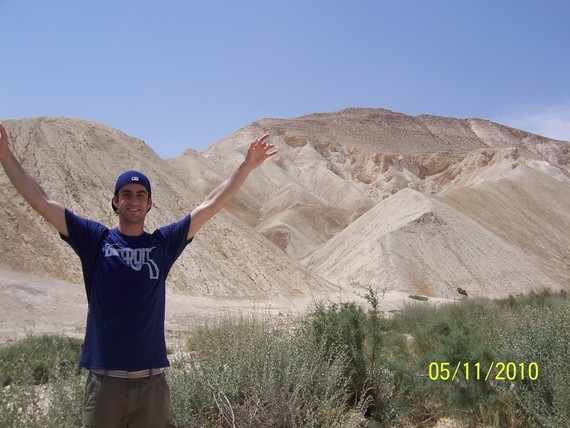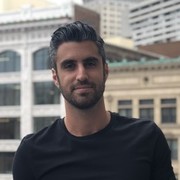SUBMIT. VOTE. WIN.
ENTRY FROM: 2016 Top Health Promotion Professionals
Nominee: Brett Powell
Born to Be Well!
I was born two years after my father founded the American Institute for Preventive Medicine. It may seem as though I was destined to work in wellness. As if my father being involved wasn’t enough, my mother is a yoga instructor. However, my path to becoming a Wellness Consultant and Vice President at the institute was anything but predictable. I initially resisted the idea of following in my father’s footsteps, instead wanting to carve my own path. Nine years later I can safely say that working with my father and the other 30 AIPM team members is the best decision I’ve ever made.

Enjoying the Israeli Desert
1. Professional Development
I attended the University of Michigan (Go Blue!) and received my degree in Psychology. Shortly after beginning my career in wellness I attended the National Wellness Conference. There I participated in a workshop taught by Larry Chapman, and became a Certified Wellness Program Coordinator. Although I was reluctant to follow in my father’s footsteps, I met so many great people at this conference that I was forced to reconsider my initial doubt. The CWPC certification certainly proved to be beneficial, however, it’s my background in psychology that I turn to more often in helping motivate people to live healthier lives.
2.Demonstrated Success
Perhaps my favorite career opportunity was one that allowed me to combine two of my passions: population health and world travel. Several years back we were approached by the largest insurance company in Peru—Pacifico. They were interested in adapting a best-practice, U.S.-based wellness program to the Peruvian population.
Employees were initially quite resistant to the idea of workplace wellness. Take the HRA, for example. We had a pretty clear idea that Peruvians weren’t going to line up to take an HRA. After all, U.S. employees need to be incentivized to take one and they are very familiar with wellness programs. We began by modifying the assessment from the University of Michigan Health Management Research Center to meet all of the cultural concerns of Peruvians. Our participation rates, however, were even worse than expected.
Along with an incredible team, we took a traditional HRA and narrowed it down to 10 actionable questions. The thought and care that went into these questions was intense. Each questions was tied to a specific action item. The entire assessment took, on average, three minutes to complete. Participation rates rose by 400% with absolutely no incentives. The client was thrilled, not just because people were completing the assessment but because it was driving them to programs they already offered and struggled to get people into.
Every single one of WELCOA’s 7 Benchmarks went into our consulting on this project.
1) We actually spent an entire week in Lima meeting with the CEO and leadership team of Pacifico. Being that workplace wellness was not a concept we really had to sell them on this idea. We knew that getting their leadership on board early was paramount to the success of the program and that proved true.
2) We created a wellness team at Pacifico for their internal wellness program as well as each of the client sites that were piloting (three in total). This is something that they were on board with as they had been working in teams already.
3) The HRA was an important piece to collecting data. They also had a program in place that was essentially our version of a biometric screening, they just weren’t calling it that. We showed them how important collecting and using that data was.
4) Our operating plan was a 40-page document that integrated the health management program with all of the other services they offered as a provider, which were plentiful. They had already invested in their own clinics, hospitals, ambulances, and physicians.
5) Choosing interventions was actually relatively simple as they had access to so many resources. The challenging part was getting the right people to the appropriate intervention, something that the HRA, screenings, and adapted communications really helped with.
6) We focused a lot of our attention on cafeteria options as this was a primary element they were in control of.
7) As a healthcare provider they were already very numbers driven and it didn’t take a lot of convincing that outcomes were important.
3. Leadership
Working in the wellness field has opened my eyes to the litany of research supporting the correlation to lifestyle and chronic disease. I exercise six days a week, eat a healthy diet (most of the time), and support others on their health journeys. Since arriving at AIPM I have revamped our internal wellness program and achieved 100% participation.
I’ve spoken at more than 60 regional and national conferences as well as authored studies and been published in the American Journal of Health Promotion.
Working with my father (Don Powell) every day has provided me with the greatest example of leadership that I could have ever imagined. He also gifted me with the introduction to many other great leaders in the field who have helped mentor me to be the leader I am today.
The best advice I can give to future leaders is find a mentor. This field is filled with great people, eager to help others.
4. Innovation
My most proud innovation has been in the area of engaging the multigenerational workforce in wellness programs. I noticed a need in this area when I began as a young millennial. My health concerns and preferred methods for programming varied drastically from my older counterparts. Because there wasn’t much in the way of research on this topic I took it upon myself to do the research and educate others.
My most recent study and results can be found here: http://healthylife.com/generations/assets/generation-white-paper_2016.pdf
We’ve implemented these concepts into many of the client programs we run, producing great results. For example, one group that used a self-care program designed to reach all generations saw an ROI of 6:1 due to an increase in people seeking the appropriate level of care. Another group saw tobacco quit rates rise by 30% due to a multigenerational approach to behavior change.
5. Compelling Vision
I believe the greatest threat to health promotion over the next five years is the environment around us. There’s a lot of money and industry that thrives upon us not being well. We’re never going to outspend the food industry or the tobacco industry, so we must outsmart them. Herein lies our greatest opportunity, which is to teach people to create their own healthy environment. Grabbing a burger from the cafeteria won’t be as tempting if you’ve already packed a healthy lunch. Your kids will eat grapes if they’re prominently displayed at eye level in the fridge with unhealthier options out of site. You’ll likely go for that walk if you’ve agreed to meet a coworker.
Empowering individuals to create their own healthy lifestyles, in a way that is sustainable for them, is the way in which I will spend my next five years and likely well beyond that.
You can vote as often as you like. You may vote once per hour per entry.
When you come back, use the search function to find this entry.
You can vote as often as you like. You may vote once per hour per entry.
When you come back, use the search function to find this entry.








Comments are in order of newest to oldest
Post a Comment